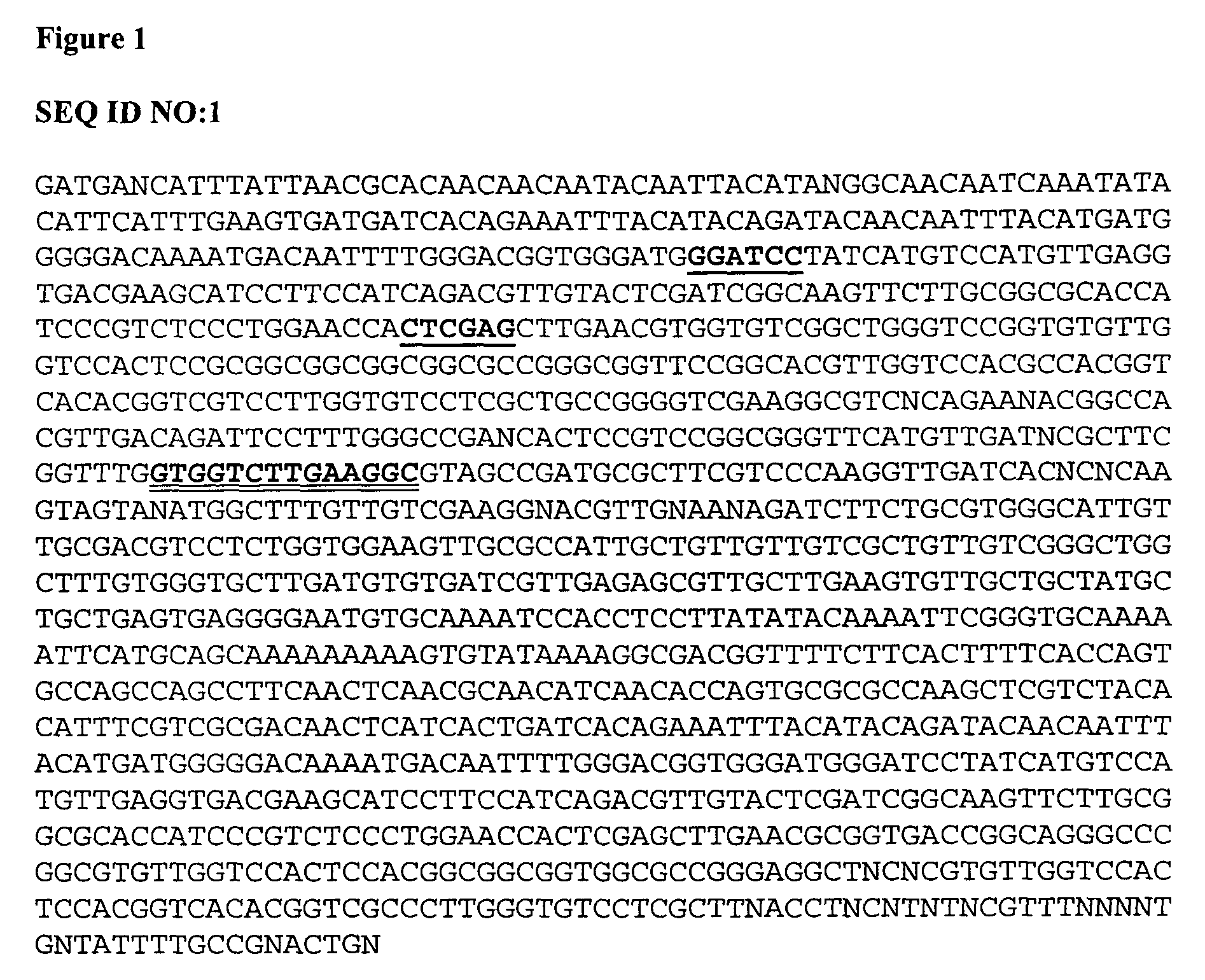Compositions and methods for controlling plant parasitic nematodes
- Summary
- Abstract
- Description
- Claims
- Application Information
AI Technical Summary
Benefits of technology
Problems solved by technology
Method used
Image
Examples
example 1
Construction of Major Sperm Protein RNAi Gene
[0180]This Example describes the construction of the expression construct for MSP dsRNA for use in RNAi. Conserved regions of the MSP gene for various nematodes were found using “Block Maker”. Degenerate primers were synthesized and a partial gene fragment was amplified from SCN genomic DNA. The fragment was cloned into pGEM-T Easy vector, sequenced, and used for a BLAST search in GenBank. The cloned sequence showed homology with MSP genes from other nematodes. The fragment was used to probe a cDNA library made from J2 juveniles.
[0181]A subclone was identified in a SCNJ2 cDNA lambda library and sequenced. This sequence is presented in FIG. 1 as SEQ ID NO:1. A T7 primer (5′ gta ata cga ctc act ata ggg c 3′; SEQ ID NO:2) and MSP specific primer (5′ cca tgg ctg cag gcc ttc aag acc ac 3′; SEQ ID NO:3; reverse compliment identified by double underline in FIG. 1) were used to amplify an approximately 600 base pair fragment of MSP. The MSP speci...
example 2
RNA Polymerase II Construct Design
[0183]This Example describes the construction of an RNA polymerase II RNAi gene. Degenerate primers were used to retrieve RNA polymerase II sequence from H. glycines. Since H. glycines RNA polymerase II sequence was unknown, the primers had to be designed using sequence from C. elegans and three other related organisms-Artemia salina (brine shrimp), Helobdella stagnalis (leech), and Ilyanassa obsolete (eastern mud snail). The RNA polymerase II sequences of these four organisms were copied into Blockmaker (blocks.fhcrc.org). The blocks formed from Blockmaker were then copied into Codehop to make degenerate primers. The sequences were also copied into Clustalw, which, like Blockmaker, is a multiple sequence alignment tool. The advantage of using Clustalw is that it provides a view of the entire alignment of the sequences rather than just blocks of alignments. Clustalw also points out regions of the alignment that have very tight homology throughout th...
example 3
Chitin Synthase Constructs
[0193]This Example describes the construction of a chitin synthase RNAi gene. Chitin synthase gene was selected because in RNAi experiments by Piano et al. (Piano F, Schetter A J, Mangone M, Stein L D, Kemphues K J. RNAi analysis of genes expressed in the ovary of Caenorhabditis elegans. Current Biology 10: 1619) showed that silencing of this gene prevents development of nematode progeny (i.e. embryo lethal). The spliced sequenced together with Blockmaker (blocks.fhere.org), Codehop, and Clustalw to make degenerate primers and amplify the chitin synthase sequence from Heterodera glycines. This sequence is providing in FIG. 12 (SEQ ID NO: 18). Sense and antisense fragments are cloned from the underlined region using methods similar to those described above. The sense and antisense fragments are then cloned into vector as described in Example 2. Primers useful for cloning the sense and antisense sequences include the following:
[0194]
CHSY151_F:CCGATGCTTAGGCTGA...
PUM
| Property | Measurement | Unit |
|---|---|---|
| Fraction | aaaaa | aaaaa |
| Electrical resistance | aaaaa | aaaaa |
| Nucleic acid sequence | aaaaa | aaaaa |
Abstract
Description
Claims
Application Information
 Login to View More
Login to View More - R&D
- Intellectual Property
- Life Sciences
- Materials
- Tech Scout
- Unparalleled Data Quality
- Higher Quality Content
- 60% Fewer Hallucinations
Browse by: Latest US Patents, China's latest patents, Technical Efficacy Thesaurus, Application Domain, Technology Topic, Popular Technical Reports.
© 2025 PatSnap. All rights reserved.Legal|Privacy policy|Modern Slavery Act Transparency Statement|Sitemap|About US| Contact US: help@patsnap.com



